
As you know, one of the most common and dangerous pathologies that can disrupt the work of internal organs and worsen motor activity is osteochondrosis of the chest region. If a person is diagnosed with this disease and he does not take timely action, it is with the appearance of severe symptoms of pain, dysfunction of the cardiovascular system, deterioration of the gastrointestinal tract, development of inflammatory processes in the respiratory tract, lack of reproductive function andother serious complications.
In this article we will give detailed information about breast osteochondrosis and talk about the main points that are associated with the development of this disease. You will also learn about risk factors, effective treatment measures and possible negative consequences. We hope that you will find the suggested material useful.
What is thoracic spine osteochondrosis?
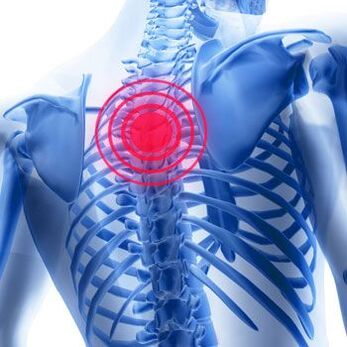
According to statistics, osteochondrosis of the thoracic spine can be observed in different people regardless of gender and age. If the disease manifests itself in children, then their musculoskeletal system is subject to premature aging.
What is this disease that we hear about so often from others? This is one of the dangerous pathologies that is accompanied by degenerative-dystrophic changes in the area of the bones and cartilage. The lack of timely treatment is fraught with destructive processes affecting joints, intervertebral discs and ligaments.
Against the background of thoracic osteochondrosis, the following pathological processes can often occur: impairment of reproductive function; pathological replacement of lung tissue by connective tissue; oncological neoplasms; inflammatory lesions of the prostate; Atherosclerosis, etc.
It should be noted that in the initial stages of the disease, pathological changes mainly affect the bones, but the disease gradually spreads to muscle, connective and cartilage tissues.
Stages of development of osteochondrosis of the thoracic region
Currently, 4 stages of the pathological process are known:
- First. It is characterized by moisture loss and the appearance of cracks in the area of the intervertebral disc. In this case, thoracic osteochondrosis has mild symptoms that disappear during the period of rest.
- Second. It is also accompanied by the formation of cracks and a decrease in the size of the disk. In this case, the free part of the vertebra is filled with the nucleus pulposus, but the probability of its protrusion in this case is minimal. However, the patient feels considerable tension in the muscle area. A strong pain syndrome becomes noticeable, which disappears after rest for a while.
- Third. The tear reaches the outermost part of the vertebra and the nucleus pulposus protrudes. This is accompanied by the appearance of a herniated disc. The patient notices the presence of constant pain.
- Fourth. It is accompanied by fibrosis. The connective tissue that is formed binds the surrounding vertebrae. In addition, there is an overgrowth of bone tissue and the active appearance on it of pathological growths.
Causes of thoracic osteochondrosis of the spine
There are several known risk factors that can provoke the progression of the disease:

- Genetic predisposition;
- Hypodynamia;
- Scoliosis;
- Regularly lifting heavy objects;
- Injury to the chest region;
- Wearing high-heeled shoes during pregnancy;
- Alcohol and tobacco abuse;
- Worsening blood flow in the spinal cord area;
- Significant physical activity;
- Exposure to thermal factors;
- Bone tissue dystrophy;
- The presence of a herniated disc;
- Obesity;
- Disruption of metabolic processes;
- Cartilage destruction.
Symptoms of osteochondrosis of the thoracic spine in men and women
It is important to note that the disease described above is also characterized by a change in the composition of cartilage tissue. This pathological process is accompanied by the following manifestations:

- A feeling of squeezing in the chest area associated with worsening airway activity;
- Regular numbness of the limbs;
- The appearance of noticeable discomfort when turning the body;
- Loss of sensitivity in the limbs;
- Brittle nails;
- The presence of a tooth in the area of the hands;
- Digestive tract disorders;
- Reproductive dysfunction;
- Painful manifestations in the head area that are regular;
- Vomiting, nausea, and heartburn;
- The defeat of the intercostal nerves, accompanied by an acute pain syndrome (neuralgia);
- Aching pain in the abdominal area;
- Significant discomfort in the left side of the chest;
- Pain syndrome in the right side of the chest;
- Tachycardia;
- Increased sweating.
Characteristic signs of the subacute phase
It becomes noticeable after a period of exacerbation. Pain symptoms and malfunctions in the respiratory system persist, but are less intense. The patient stops looking for a position to get rid of the discomfort. The duration of the subacute phase is up to 12-14 days. If the advice of a specialist is strictly followed, remission with a characteristic weakening of pronounced signs is possible. Failure to follow the recommendations can lead to repeated exacerbation of the disease.
Remission of osteochondrosis of the thoracic spine
This stage is characterized by a temporary improvement in the patient's condition. In this case, the symptoms can return - when exposed to thermal irritants or changes in climatic conditions. The acute pain syndrome is only noticeable in thoracic osteochondrosis of 2-4 degrees - due to a sharp change in body position. Excessive physical exertion, stressful situations, chronic symptoms in the acute stage and an immobile lifestyle can also cause a relapse.
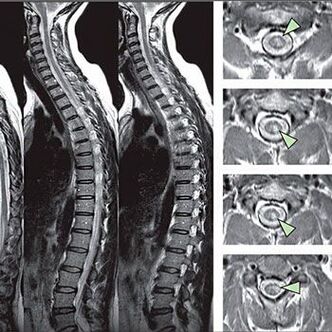
Methods of diagnosing osteochondrosis of the thoracic spine
For a clear diagnosis, the specialist must take the patient's complaints into account. The following symptoms and sensations in women make it possible to identify thoracic osteochondrosis: if you press certain points in the chest area, a severe pain syndrome occurs.
Special functional tests are carried out to detect signs of impaired sensitivity. The most informative diagnostic option of instrumental methods is X-ray. However, MRIs and CT scans are often done to thoroughly examine the spine. If there is a suspicion of diseases of the cardiovascular system, an EKG procedure is recommended to the patient.
First aid for acute thoracic osteochondrosis of the spine
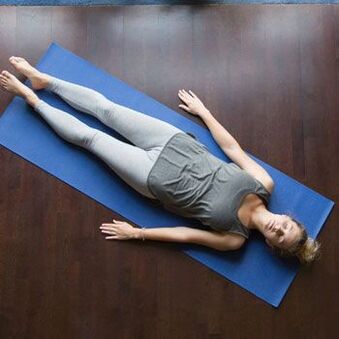
Pain manifestations during the recurrence of the disease are characterized by a penetrating acute character, which implies emergency care for the patient. It must be placed on a flat surface and covered with a warm blanket. If anxiety, shortness of breath or tachycardia occur in the event of a relapse, a specialist should be consulted immediately. To relieve pain in the intercostal area, it is recommended to resort to nonsteroidal anti-inflammatory drugs.
Treatment of thoracic osteochondrosis of the spine
To understand how best to treat chest osteochondrosis, one should remember the basics of a comprehensive technique. As part of this, several therapeutic measures are carried out at the same time, thanks to which it is possible to cope with almost all signs of pathology. In the case of an initial illness, conservative therapy is used. With more advanced stages of the pathological process and the presence of herniated discs, surgical intervention may be required to get rid of compression syndrome.
Physiotherapy treatment
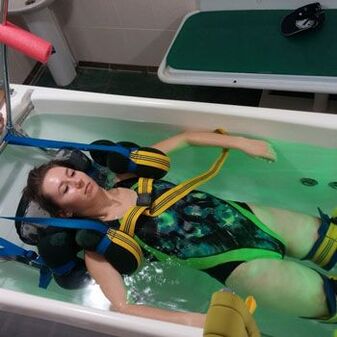
In order to understand how to treat osteochondrosis of the thoracic spine using physical therapy methods, it is worth remembering its mechanism. The most effective in identifying the above pathology are:
- Exposure of the body to constant electric current with simultaneous use of medication;
- Methods related to the use of a static magnetic field;
- Phonophoresis;
- Ultrasound therapy;
- Hydrotherapy and underwater spine traction.
SWT in breast osteochondrosis
Shock wave therapy is considered to be one of the most effective methods to restore the affected parts of the spine. This physiotherapeutic method is based on the effect of acoustic impulses on the zones affected by the destructive-degenerative process.
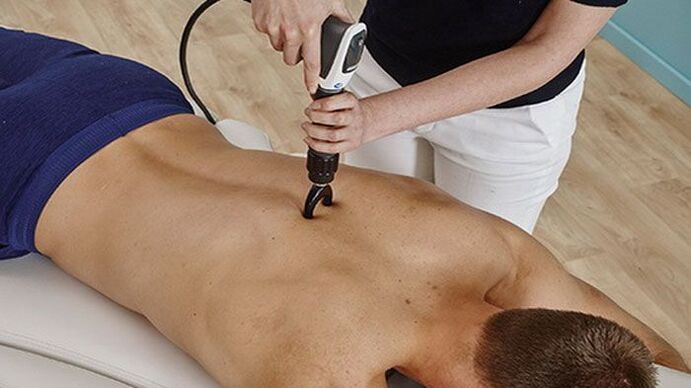
In this case, special medical devices are used. By converting electrical impulses into shock waves, it is possible to quickly cope with salt deposits, shrink osteophytes and minimize the intensity of pain.
Typically, the procedure is effective for cervical, thoracic, and lumbar osteochondrosis. Its main goal is to restore the normal condition of joints, bones and cartilage, as well as to increase the elasticity of the affected vertebrae. In addition, shock waves can activate the formation of new blood vessels and improve blood flow to the muscles.
acupuncture
This technique involves inserting small diameter needles into biologically active points. To activate a positive effect, they are rotated around an axis or heated. With the help of acupuncture, it is possible to quickly stop the pain syndrome, eliminate inflammatory and congestive manifestations, cope with swelling, relieve spasms, restore normal blood flow and improve mobility.
Pharmacopuncture
The method of administering drugs through reflexogenic points. In this case, drugs are injected into the lesion.
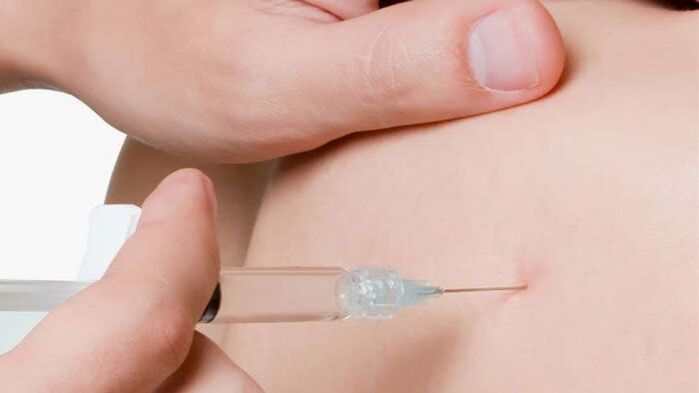
Taking into account the intended use, the following drugs are used:
- Means to reduce the tone of skeletal muscles and restore the mobility of the vertebrae;
- Drugs with analgesic and anti-inflammatory effects;
- Medicines that reduce muscle tone and widen blood vessels;
- Preparations that accelerate recovery and metabolic processes;
- Vitamin complexes that help normalize cell nutrition and improve the functioning of the immune system;
- Homeopathic remedies for normalizing the immune system and the musculoskeletal system.
Massage for osteochondrosis of the thoracic spine
It should be noted that massage in this department can also be carried out in an acute phase. Thanks to this, it is possible to restore blood flow, improve the condition of muscles and normalize their functionality, as well as minimize the load on the vessel that supplies the brain.
taking medication

When we talk about how to treat thoracic osteochondrosis with drugs, the first thing to consider is the degree of the disease, the nature of its appearance and the intensity of the pain syndrome. Most often, the following drugs are used:
- Nonsteroidal corporate funds. These are drugs with anti-inflammatory, analgesic effects, which should be used in a course, at the end of which they are switched to special ointments.
- Anesthetics. They have an analgesic effect. Used as an intravenous drip;
- Diuretics. Allows you to cope with puffiness, eliminate signs of pathologies, positively affect the state of the myocardium;
- Medicines that reduce the tone of the skeletal muscles, restore the mobility of the vertebrae and relieve pain.
In some situations, the patient is recommended to take hormonal drugs, anticonvulsants, vitamin complexes, drugs to restore the condition of blood vessels and sedatives.
Injections for osteochondrosis of the thoracic spine
Patients are often interested in what to do with thoracic osteochondrosis when it is accompanied by acute symptoms. To get a faster effect on the nerve endings, they resort to injections into the spine. In this case, anesthetics and glucocorticosteroids are used. After the patient's condition normalizes, they switch to the use of gels and ointments.
Gymnastics for the thoracic spine in osteochondrosis
Before performing exercises for the thoracic spine with osteochondrosis, it is recommended to do a warm-up, which will cause the necessary warming up of the muscles and increase the effectiveness of future training. You can also take a shower and massage the spine lightly in the chest area.

Warming up is of particular importance for those patients who are doing gymnastics at home for the first time with thoracic osteochondrosis. As part of the warming up of the muscles, the following movements can be performed: Twists and turns of the pelvis and neck, rhythmic movements of the limbs, performed in different directions (swing). It should be remembered that gymnastics for thoracic osteochondrosis is carried out without hurry and smoothly. If the exercise is associated with acute pain syndrome, then it is better to refuse.
Currently, the thoracic spine gymnastics recommended for osteochondrosis includes performing 6 basic exercises:
- The patient is placed "lying" face down on the floor. At the same time he crosses his hands behind his head and spreads his elbows wide apart. In addition, at the same time as the body, the shoulders are gradually raised, which is accompanied by an alternating movement of the elbows in the same direction. The number of repetitions is 6 times 6 times for 1 exercise;
- The patient is placed face down on the floor. Then he ties his hands behind his back in a lock and tries to lift them up by bending the body. All movements are very fluid;
- The person takes a standing position and puts their hands behind their shoulders. In the future he should lift (alternately) with his shoulders raised;
- The patient lies on a flat surface on the floor and supports himself on his stomach. He stretches the upper limbs in front of him and lifts the body slightly;
- The patient is placed on a chair and lowers his hands to the waist area. In addition, movements are performed with the shoulders, with alternating lifting and slow return to the starting position. The number of repetitions - 5 times in one lesson;
- The man is sitting on a chair and trying to reach up with an exercise stick. The return to the starting position occurs on the exhale, while the body is leaning forward. You can also do side bends while holding the same exercise machine in your hands.
Diet for breast osteochondrosis chondr
According to the expert, it is better for people suffering from this disease to exclude from the diet fatty foods, smoked products, marinades and preservatives. You should also reduce the amount of salt as it can cause severe swelling. In addition, the amount of fluid ingested should not be less than 2–2. 5 liters per day.
Surgical intervention
Depending on the clinical manifestations of thoracic osteochondrosis, specialists choose the appropriate treatment. In advanced cases, surgical intervention is performed, as part of which:
- Excision of the intervertebral disc;
- Removal of a herniated disc;
- Surgical intervention for spinal stenosis;
- Replacement of the hard disk.
Traditional methods of treating thoracic osteochondrosis of the spine
As a rule, the methods of conventional medicine are considered relevant after the main therapy has been completed. In this case, herbal infusions and decoctions, compresses, various ointments and gels can be used. Basically, such funds are used to relieve painful manifestations of low intensity that become noticeable after physical exertion. The following recipes are most commonly used:

- Peel, grind and squeeze the celery juice. The resulting raw material is mixed with celery. The main purpose of this tool is to combat salt build-up in the spine;
- Dry sunflower roots are crushed and hot water is added to the mixture. Cook over low heat for about 15 minutes, then insist and filter. Take 3 times throughout the day.
Medication during pregnancy
It should be remembered that most anesthetics are not allowed during pregnancy. Neurologists recommend limiting your intake of gels, ointments, and patches. Most often, if a pregnant woman is diagnosed with osteochondrosis of the chest region, treatment is limited to performing physiotherapeutic exercises and massages, the beneficial effects of which are provenResults from people. . .
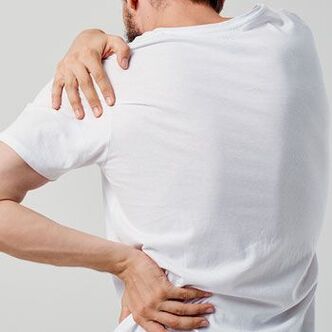
Possible complications
If a patient is diagnosed with thoracic osteochondrosis, but he has not taken timely action, it can lead to malfunction in the gastrointestinal tract, inflammation of the respiratory tract, violation of the heart rhythm, as well as deterioration in reproductive function.
With severe compression of the nerve endings, they can be noticeable:
- Pathological processes in the kidney area;
- Pain syndrome of a chronic nature;
- Deterioration in cardiac activity;
- Development of a herniated disc;
- Stiffness in the spine.
Preventive measures
To exclude the likelihood of negative consequences against the background of breast osteochondrosis, any experienced doctor advises you to adhere to the following rules of prevention:

- Eliminate exposure to thermal irritants;
- Refuse to consume tobacco products and alcoholic beverages;
- Perform gymnastics exercises;
- Track Your Attitude;
- Refuse smoked meat and spicy foods;
- Sleep in a comfortable bed;
- Eliminate increased physical activity;
- 1 time in 6 months to take drugs that allow you to restore cartilage tissue;
- Regularly visit a specialist to examine the condition of the spine.
With the timely detection of pathologies and the implementation of effective therapeutic measures, the prognosis is positive.






























